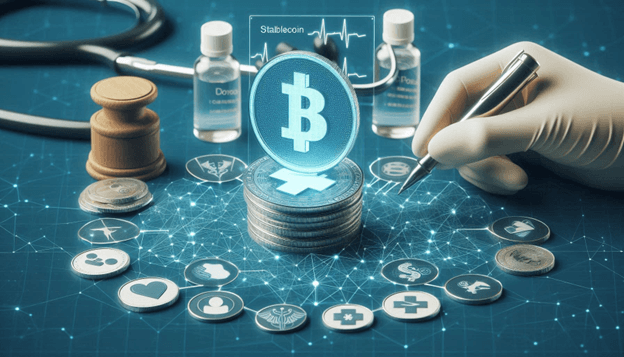Stablecoins in Healthcare: Could They Revolutionize Medical Payments?
Published Date: 12 Oct 2024
Introduction
Stablecoins and various innovations within the sector have appeared and the usage of digital currencies in the health-care industry is also promising. Stablecoins are relatively new, digital assets that are touted to have less volatility, for they are tied to fiat currency or a basket of them. This stability makes them suitable for many financial transactions among them being medical dues. This kind of money is called stablecoin, and in this blog, we will attempt to discuss what it is, how it might be used in health CMCs, and whether it also poses threats or opens up opportunities.

Understanding Stablecoins
Stablecoin is a special kind of cryptocurrency that is backed by some reliable asset, such as USD, EUR, or gold. Stablecoins, therefore, provide more stable value than traditional cryptos like Bitcoin and Ethereum, which are known to be extremely volatile. They are ideal for routine buying and selling and other operations because of their nature.
Stablecoins come in three primary varieties:
- Stabilized coins with fiat collateral:
These are backed by a stock of fiat money such as the US dollar, the Euro, etc. Similar to how each stablecoin is created, an equal amount of fiat money is held as reserves.
- Crypto-collateralized stablecoins:
Cryptocurrencies that are pegged to another coin but have more backed up to cater to potential fluctuations of the underlined asset.
- Algorithmic stablecoins:
These do not have a physical form backing them but rather entire algorithms to prevent the circulation of too much stablecoin while at the same time maintaining its price constant.
Potential Uses in Medical Fields
Due to their many benefits, stablecoins have the potential to completely transform medical payments:
- Lower Transaction Costs:
Online credit card payment and bank transfer are two familiar examples of conventional payment methods, which often involve high payment processing costs. Stablecoins can reduce these costs by a significant margin thus making payment of medical bills achievable for the patients and medical caregivers as well as other stakeholders.
- Instantaneous Transactions:
The most important aspect of stablecoins is that transactions are fast – nearly real-time as opposed to payment systems which may take days. This can be particularly useful in cases of M-commerce and International remittances as well as medical bills.
- Greater Accessibility:
Stablecoins also provide a form of financial access for the unbanked, which includes distant or underdeveloped areas. In general, there is no need to have a regular bank account to perform a payment in the use of stablecoins.
- Enhanced Security:
Due to blockchain which stablecoins utilize, the transaction involves a safe and transparent process. Apart from safeguarding the medical payment purity, this can reduce fraudulent risks.
- Improved Financial Inclusion:
Since stablecoins provide the public with safe and stable cryptocurrency that is easily accessible, they can improve the population’s financial literacy of the unbanked or underbanked population18. This will go a long way in addressing the existing disparity in health care services with a view of bringing the disparity between the different groups in society.
Challenges and Considerations
Although stablecoins have many advantages, there are certain issues and things to keep in mind as well:
- Regulatory Compliance:
If stablecoins are to be used in the healthcare ecosystem, then it should follow the rules and regulations currently governing finance today. This comprises ensuring that transactions are secured and well as should be assured that stablecoins are well-regulated.
- Volatility Management:
But still, stablecoins are not protected entirely against volatility risks, which is quite unexpected, given their names. Medical payment stablecoins have to maintain stability and dependability by having efficient measures to control the fluctuations in price.
- Technical Infrastructure:
The utilization of stablecoins in the field of healthcare requires a robust technological platform and protected wallets and banking means. For normal patients and other healthcare workers to be able to transact in stablecoin they need simple platforms to use that will not cause any swings in the market.
- Privacy Issues:
Several concerns have been mentioned regarding blockchain technology The issue of privacy aside from the issue of transparency is a drawback. From the medical payments perspective, it means that the information about patients and transactions should be secured to maintain the trust level and confidence.
- Adoption and Education:
This means that patients, healthcare personnel, and regulatory bodies need to have a clue about stablecoins for the stablecoin to gain momentum within the healthcare sector. The transition to payments in stablecoins can be made with the help of educational activities and manuals.
Conclusion
As stablecoins offer faster transactions, reduced transaction charges later, improved access, better security, and improved financial inclusion, they have the wow factor to revolutionise the medical payment system. To be fully realized, however, the following challenges such as acceptance, privacy, technical requirements, volatility management, and regulatory matters must be addressed.
Maximize your value and knowledge with our 5 Reports-in-1 Bundle - over 40% off!
Our analysts are ready to help you immediately.
